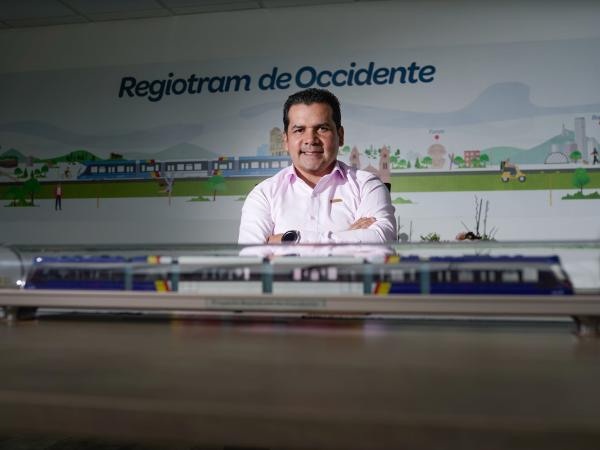After the endorsement of the National Environmental License Authority (Anla), the Western RegioTram project is moving forward at full speed.
In an interview with Portafolio, Orlando Santiago Cely, general manager of the Férrea Regional company, spoke about the progress of the work, in which he pointed out that They will begin to intervene the existing railway network before the end of this month. He highlighted the challenges of the corridor and how they hope the project will be ready by 2027.
You can read: Freight mobilization by rail doubled in 2023: more companies sign up
Anla gave them free rein environmentally, what’s next?
Decree 510 recognizes that environmentally friendly railway projects, which use existing corridors, do not have the need to go through a licensing process, but seeing that the environmental benefits are more than the impacts, it equates it to other types of mass transportation projects such as the Bogotá metro, which, due to being within the same jurisdiction, in the same city, does not require licensing processes.
That does not mean that we will no longer comply with environmental guidelines. Quite the opposite, the instrument that we are going to start using is an Environmental Guide Adaptation Plan, well known as PAGA, which will allow us to have an environmental instrument for the development of the works, complying with all the requirements and having to advance permits before the territorial authorities.
How is the project progressing against the schedule?
We are doing well with what is planned. Our goal is to complete the construction stage by the end of 2026. With that completion, what would follow is a stage of verifications, to ensure that what is built was well built, especially because as it is a 100% electric train, its electrical system It has to work perfectly along the road, that stage is known as white walking.
This check in the contract is expected to last a maximum of six months, so we hope that by mid-2027, we will already have our commercial operation of the train.
Initially, it was scheduled to begin operating in 2026. What caused the delay?
Well, the schedules have been moved somewhat. The main fact that made the schedule run is obtaining the environmental license, having not been able to obtain it last year, and here without the license we could not build, now with this new figure we already have spaces where we can build.
Also read: Apps are making their way into intermunicipal transportation: the union’s concerns
Orlando Santiago Celis, general manager of the railway company
Sergio Steel
How much is the investment in construction?
A concession contract has several stages. The first was to advance designs to build, then continue with the construction stage and then an operation and maintenance stage for more than 20 years.
In the case of costs, a part is paid in the construction stage, but trains, for example, will be paid later during operation. In general, this is an estimated investment of $2.7 billion without counting trains.
And when does construction on the railway start?
At this moment we are finalizing all the design topics, but we have found that there are places where the design topic has already been exhausted and that we could start doing work, so we are in that transition from going from designs to 100% construction.
During the intermission we saw the opportunity to start doing some work in advance. One of those works is the Corso workshop, the place where the trains will be maintained and where they will sleep. This work, one of the largest of the project, began in the middle of last year and today is 16% complete.
Soon, with the progress of completed designs, we will be able to begin work on the main corridor.
When does construction of the second workshop patio begin?
It is an annex to the corridor, it is not a large infrastructure that requires starting early like the other one, so when we are building in that area near 68th Avenue, we will build that patio.
And when will they start working on the corridor?
We are finishing closing. What we want to do is find a section where the design issue is on the other side, and that does not have the need to request environmental permits. In the meantime, we begin to request the permits that are required along the way, in such a way that as permits are obtained, more areas are enabled for us to be able to carry out works in those places.
But will it be this year or the next that they will start working on it?
We hope to start before the end of this semester. That’s our goal, but we need to align design progress with permit applications to get started.
Read also: By public transportation and on foot: transportation preferences for Bogota residents in 2023

Regiotram of the West.
Private file
What challenges have you had in the project?
One of the challenges was the definition of network transfers. In this corridor of about 40 kilometers, there is interference with networks of about 18 different public service operators, such as aqueducts, even electrical, telephone or internet services.
In this context, perhaps the network that has the most difficulty to resolve is the fuel network that passes through the corridor, managed by Ecopetrol and Cenit. We have to make complex transfers from a technical and economic point of view. For this reason, we ask the national government to help pay for these network transfers that are concentrated in specific places. The president has told us that they are going to pay for these transfers through Ecopetrol, which eliminated the risk that the project could not be completed.
You may be interested in: TransMilenio Las Aguas and Gold Museum stations will be temporarily closed
What are the great benefits of this project?
It has two great benefits fundamentally. The first is in travel time savings. Today, a person from Facatativá can take about three hours to get to the city center. What this project will seek is to reduce that time to just one hour.
The second great benefit from an environmental point of view, let us remember that this is a 100% electric train, which will help reduce pollution. According to our estimates, in 20 years of operation it can reduce up to around 165,000 tons of CO2.
PAULA GALEANO BALAGUERA
Portfolio Journalist












Add Comment